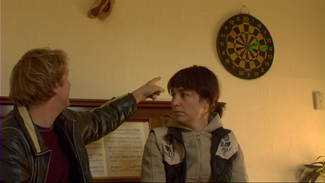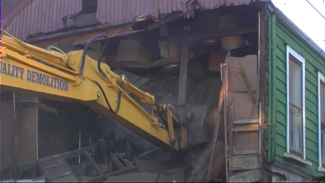
| |
| ||||||||||||
In collaboration with Emma Bugden, 2 simultaneous non-sync video projections. First screening: Blue Oyster Gallery, Dunedin, New Zealand, November, 2004. In Three Minds by Bridie Lonie When artists collaborate, they work with the power that two minds have of producing a third quite different and surprising one. A story is no longer a single voice but many. Its very inconsistencies give it what has been called density, or thickness: not as in a plank, but as in capable of providing the richness of that El Dorado of the arts, "reality". Film, still or moving, adds a third presence, playback showing more than what was immediately available to sight. At the Blue Oyster Gallery, artists Emma Bugden and Colin Hodson recorded in different ways the demolition of sections of central Wellington, planned since the 1960s. Public protests, rallies and marches have made certain houses famous, with painted lines indicating the proposed motorwayís route through them. Hodson recorded the demolition of a block, including his house. Bugden, well aware that her small street was on the list, decided to record it before it went. The two films, of different lengths, were looped and projected side by side at the Blue Oyster. The demolition film was surprisingly beautiful. Demolition is a skill, with passages of speed and passages of deliberation. With the back of its metal hand, a demolition machine knocks the edges of a building in careful order until its walls fall inward. In slow motion, debris falls into place, as materials demonstrate their own laws. A worker quiet-ly sweeps the remains of a tiled floor, discovered incongruously below the 19th-century working-class buildings. The process is witnessed by people who were perhaps past residents, collecting bricks and copper pipe. In Bugden's work, 10-year-old Dusty Johnston (pictured above), resident of one of the small row of cottages in Footscray Ave, took the film-maker through the houses, talking to this small community of primarily young people living in more-or-less temporary accommodation. Surrounded by gardens, these cottages look as if they might have been small paradises when first built. They remain so for younger inhabitants who must be prepared to move when the bulldozers come in. But relationships are formed, work done, life experienced in the fullness of the present. Together, the films provide an odd conjunction of the disorder of daily living with the order-liness of the demolition process. The enthusiastic child moving through her small community with its pets, its pianos and its unrefurbished hallways matches with her vigour the programmed intelligence of the demolition machinery: child and bulldozer, each eating the future in their different ways. The Listener, December 18-24 2004. |     | ||||||||||||